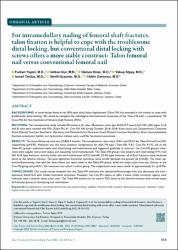For intramedullary nailing of femoral shaft fractures, talon fixation is helpful to cope with the troublesome distal locking, but conventional distal locking with screws offers a more stable construct. Talon femoral nail versus conventional femoral nail

View/
Access
info:eu-repo/semantics/openAccessDate
2022Author
Yapıcı, FurkanGür, Volkan
Onaç, Osman
Alpay, Yakup
Tardus, İsmail
Üçpunar, Hanifi
Çamurcu, Yalkın
Metadata
Show full item recordCitation
Yapici, F. (2021). For Intramedullary Nailing of Femoral Shaft Fractures, Talon Fixation is Helpful to Cope With the Troublesome Distal Locking, But Conventional Distal Locking With Screws Offers a More Stable Construct. Talon Femoral Nail Versus Conventional Femoral Nail. Turkish Journal of Trauma and Emergency Surgery. 28(4) pp. 513-522, https://doi.org/10.14744/tjtes.2021.55867 Abstract
BACKGROUND: A novel-design femoral nail (FN) with distal talon deployment (Talon-FN) has emerged in the market to cope with
problematic distal locking. We aimed to compare the radiological and functional outcomes of the Talon-FN with a conventional FN
(Con-FN) for the treatment of femoral shaft fracture (FSFs).
METHODS: This retrospective study included 85 patients (57 men, 28 women; mean age: 46.8±23.9 years) with FSFs (AO types 32-A
and B) who were treated with FNs (Talon-FN: 41, Con-FN: 44) during October 2014–2018. Knee injury and Osteoarthritis Outcome
Score Physical Function Shortform, Hip injury and Osteoarthritis Outcome Score Physical Function Shortform, Short musculoskeletal
function assessment bother and dysfunction indexes were used for functional assessment.
RESULTS: The mean follow-up time was 25.8±6.7 months. The complication rates were 19.6% and 20.5% for Talon-FN and Con-FN,
respectively (p=0.92). Malunion was the most common complication for each FN type (Talon-FN: 9.8%, Con-FN: 9.1%). All of the
Talon-FN group’s malunions were axial (shortening and malrotation) and happened gradually. In contrast, the Con-FN group’s malunions were angular (varus and valgus) and caused by initial malreduction. The Talon-FN group’s two patients with shortening (4.9%) had
AO 32-B type fractures, and the other two with malrotation (4.9%) had AO 32-A3 type fractures, all of four fractures were localized
distal to the femoral isthmus. The post-operative functional outcomes were similar between the groups (all p>0.05). The mean operation/fluoroscopy time and the mean blood loss were lower in the Talon-FN group, while the mean union time was shorter in the
Con-FN group (all p<0.01). No nonunion was noted in either group. The reoperation rates were similar at approximately 5% (p=0.95).
CONCLUSION: Our study results revealed that the Talon-FN shortens the operation/fluoroscopy time and decreases the intraoperative blood loss with similar functional outcomes. However, the Con-FN seems to offer a more stable construct against axial
malunion with a shorter bone union time. The Talon-FN should not be used in FSFs distal to the femoral isthmus with certain types
of fractures prone to shortening and malrotation.
















